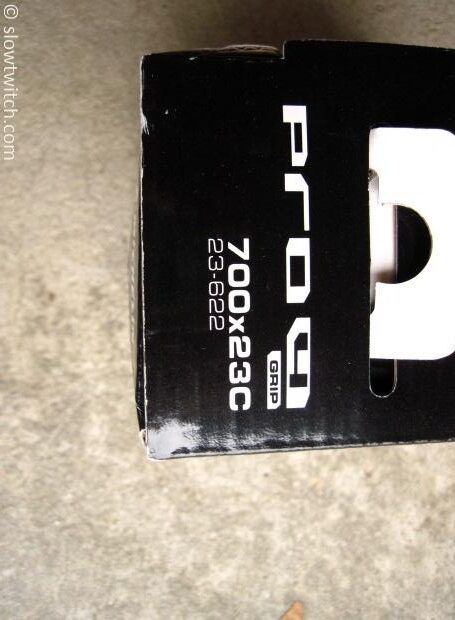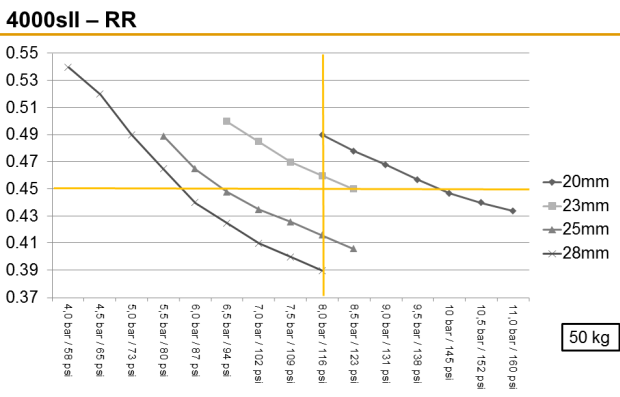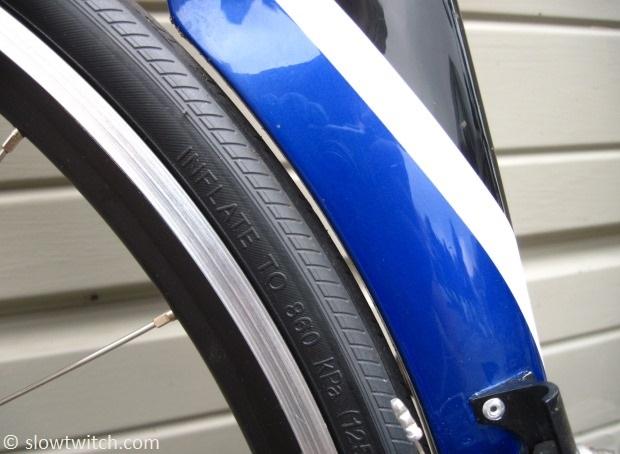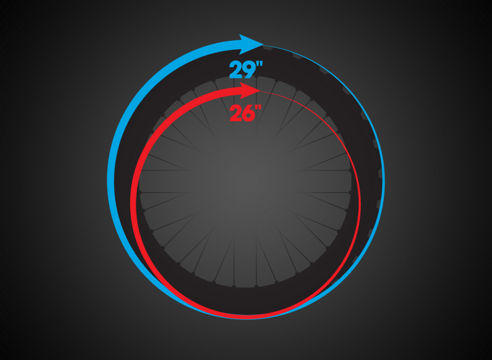Choosing your tire width
We tend to get very in-depth here at Slowtwitch, but I thought it was a good time to address something simple that is often overlooked or misunderstood by new triathletes: What size tire should you ride? Some might even be surprised that – yes – there are different sizes and widths available. Just because a certain type or size was on your bike when you bought it does not mean that it’s the best choice for you. While tire choice isn’t something that’s going to influence your outlook on life, there are some simple things to consider that could and should influence your next tire purchase.
Basic Terminology
There are two very basic things to understand about your tire – the diameter and width. Here is an example of how that width is written for most road bikes today:

The two key numbers are ‘700’ and ‘23’. 700 refers to the diameter of the tire, and 23 refers to the width (both in millimeters). For the long explanation of these numbers, take a look at the story linked at the bottom of this page – Wheel Size Wars.
On a ‘700c’ wheel, you can have a range of different widths. 23mm wide tires have been the standard for most road cycling over the past couple decades. You might see a 700x20c, or a 700x25c. On a cyclocross bike or 29-inch mountain bike, you could see tires as wide as 700x35c or 700x58c.

When it comes to diameter, there are far fewer options for road and triathlon bikes compared to the options in width. 700c is typically used on larger bikes, and 650c is used on smaller bikes. Note that you must always use the same diameter of wheel that came with your bike. If, for example, you tried to put a small diameter 650c wheel and tire on a bike built for 700c wheels and tires, the brake pads would not physically touch the wheel… so you couldn’t stop the bike. In addition, if you tried to mount a small 650c tire on a large 700c wheel, you couldn’t physically mate the two; they just wouldn’t fit.
Nuances of Width
Let’s pretend that you have a triathlon bike with 700c wheels and 23mm wide tires (e.g. 700x23c). That’s the ‘standard’ today, so chances are your bike has this exact setup. Why might you pick a different width of tire?
The general tradeoff to consider is this: Narrower tires tend to be lighter weight and more aerodynamic. Wider tires tend to be more comfortable and have lower rolling resistance (e.g. they roll slightly faster over the pavement). Tire width generally does not have any blanket effect on its puncture resistance.
Let’s hit each of these key considerations one-by-one.
Weight
Weight is pretty easy to understand. If your bike weighs less, there is less weight to carry around… so it’s easier to pedal up hills. With tires, I tend not to worry about buying the absolute lightest tire – the attributes of aerodynamics, puncture resistance, and rolling resistance are all more important to me (and there are so many other places to save weight on a bike). For racing, I would not buy a super heavy tire, but not because it is heavy. Most of those very thick tires also have a stiff casing, which tends to be higher in rolling resistance and have a harsher ride quality. It is those other consequences of the weight that are deal-breakers.

Aerodynamics
As we can all expect, narrower tires tend to be more aerodynamic. There is less tire for the wind to ‘see’. There is something else to consider aside from just your tire width, however – the width of the rim on which it is mounted.
Put simply, the width of the tire and rim should roughly correlate. There is less aerodynamic penalty with a wide tire when you use it with a rim that is also wide. The two pieces put together make a relatively smooth shape, compared to a very wide tire on a narrow rim (which tends to look like a lightbulb).

The other reason that your rim and tire width should correlate is that it affects how easily you can remove the wheel/tire from the bike. Most standard caliper brakes have a small quick release handle to easily spread the pads apart for wheel removal:

This lever can only open the brake a certain amount. If the rim and tire are of similar width, the brake will open sufficiently to allow the tire to pass through. If the tire is a lot wider than the rim, the brake cannot open enough to let the tire through, forcing you to make a more difficult adjustment (e.g. loosening the brake cable).
Ride Comfort
Ride comfort is straightforward. If you have more tire underneath you, you’re effectively riding on a larger pillow of air. This tends to mean that the ride is smoother. Less tire = less pillow.
What we need to understand, however, is that pressure is necessarily related to this ride comfort. Lower pressure lowers the spring rate of the tire, making it more comfortable. If you go too low, however, you can bottom out the rim on bumpy roads, causing a ‘pinch flat’ to your inner tube.

Above image © Trek
Wider tires allow you to use a lower pressure with less risk of pinch flatting compared to narrower tires. If you use the same pressure on a 23 and 25mm tire, the 25mm tire has 2mm more distance that must be compressed before the tube will pinch. Narrower tires must be ridden at higher pressure.
Rolling Resistance
In simple terms, rolling resistance is the amount of power loss caused by your tire as it rolls down the road. This does not mean that it’s the coefficient of friction between the tread and the asphalt. It is the amount of energy that the tire ‘uses up’ as the casing contacts the pavement and deforms, and then returns to its normal shape as it leaves the pavement. Not all tires are created equal in this regard. Most of the latest research shows that – for a given type of tire – the wider tire has slightly better (lower) rolling resistance.

Rolling resistance tends to correlate with puncture resistance and weight. Lighter tires are usually more flexible, meaning that they sap less energy when they flex and return to shape. Lighter tires also tend to be more susceptible to punctures because they’re thinner. It’s a tough situation – the fastest rolling tire is almost never the tire that you’d want to ride for an Ironman, due to its necessarily lower puncture resistance. You must pick a tire that fits your personal level of comfort with flat protection. This is a huge area of interest to tire manufacturers, who are constantly trying to find ways to make tires roll faster, but retain a good level of durability.
Training vs. Racing tires
You might hear people call a tire a ‘training tire’ or ‘racing tire’. What are the key differences between the two?
The big secret is this: There is no such thing as a training tire or a racing tire. There are no actual minimum standards to call a tire either name. There is no governing body that regulates it.
What people are really telling you is that a ‘racing’ tire is similar to a racing car – you give up durability for performance. You make a risk, hoping for a reward. In other words – they weigh less, roll faster, are more prone to punctures, and cost more. A training tire tends to be the opposite – they weigh more, roll slower, are more resistant to punctures, and cost less. Unfortunately there is no free lunch and you can’t have it all.
Width Accuracy
It is worth noting that the width of the tire printed on the label isn’t always accurate. I’ve had ‘25mm’ tires that actually measure 23mm… and ‘25mm’ tires that actually measure 28mm (on the exact same width of rim). That’s a huge range of error, and a real problem for our industry.

Note that I did mention rim width – this has an influence on effective tire width (tech detail: only for clincher-type tires). If you put a 23mm tire on a 19mm-wide rim, it will measure narrower than the same tire on a 22mm-wide rim. Tires also grow slightly with age and high pressure.
What we pose to the industry is this – printed tire sizes ought to be taken from actual tire measurements. In addition, the rim width that they use ought to correlate with the tire width. Perhaps that means that 20mm tires are measured on 20mm rims and 23mm tires are measured on 23mm rims. This can’t remain a 1:1 ratio as tire sizes really grow, but it should be in the ballpark. Maybe I’ll start my own protest in the streets of America to begin the movement. Join me?
How do you decide?
In general, the tire that came on your bike is a good place to start. If you have 23mm tires, your bike will probably continue to do fine with 23’s.
My general advice to most people is this:
1. For training, err to larger and more durable tires. I personally pick the largest tire that will fit inside my brake and frame. On many road or triathlon bikes, this is a 25mm tire (some may go up to 28mm).

2. For racing, I err towards narrower and faster rolling tires. On most modern race wheels (which are moving to wider rims), I typically choose a 23mm tire. It can be hard to find rolling resistance information, so I usually pick the tire that each manufacturer calls their ‘second fastest’. The ones that are super light and super fast-rolling are usually beyond my comfort zone of puncture protection for self-supported racing like triathlon (e.g. there is no ‘team support’ van waiting behind you with spare wheels). The heavy training tires roll slower than I’m willing to deal with for a race.
3. I always trend my tire width with how rough the pavement is – regardless of whether I’m training or racing. If I know a course is very rough, I’ll race on 25mm tires. If I’m training on rough roads, I’ll saddle up with fat 28mm tires. Especially for riding on aerobars, tire comfort makes a huge difference. Road bikes allow you to bend your elbows to absorb shock, making tire comfort less important. On a triathlon bike with aerobars, you ride right on your elbows, so every bit of ‘tire suspension’ counts. Of course, if I know the pavement is smooth, I pick a narrower and more aerodynamic tire.
—
What do you think? If you’re a beginner, did you know much about tire sizing? Are you interested in the fastest tire, the most durable tire, or something else entirely?








Start the discussion at forum.slowtwitch.com